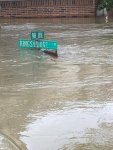Hello to all,
Was helping to demo [remove sheet-rock, cabinets floors,etc] a house of a hurricane post-flood victim. The problem is that the USACE's released reservoir/dam waters for 14-18 days that keep homes in 3-8 ft of water after hurricane left. This was a major bayou and a waste treatment plant was also flooded and h-waste was continuously released into the waters too, to the turn of 40-50PPM higher than the highest end of the bad side [per Baylor College of Med's Cell Bio Dept]
The house I worked on yesterday also had a pool. The couple was in their early 80's. The pool was obviously disgusting and also had many diff sizes of small fish [6" to 1/2"]. The water was more brown than green and did not smell very good at all. I volunteered that when they were ready, I would use some TFP techniques w my TF-100. but where do you start? The pump and all equipment had been under water for 14days. the pump would start and actually run, but the homeowner said it was much louder than normal...prob bad or near bad bearings.
Considering e-coli and other things from the waste treatment plant, how does one even start something like this? I felt really sorry for them bc everything they owned was ruined and tossed. The only good thing about the fish is they were eating the mosquito larvae that you could see swimming at the top. Over 1,400 homes like this along the bayou where the release waters from the reservoirs went 1/3 mile out of banks...the losses are incalculable at this time. I felt guilt coming home to a sparkling TF-pool
Was helping to demo [remove sheet-rock, cabinets floors,etc] a house of a hurricane post-flood victim. The problem is that the USACE's released reservoir/dam waters for 14-18 days that keep homes in 3-8 ft of water after hurricane left. This was a major bayou and a waste treatment plant was also flooded and h-waste was continuously released into the waters too, to the turn of 40-50PPM higher than the highest end of the bad side [per Baylor College of Med's Cell Bio Dept]
The house I worked on yesterday also had a pool. The couple was in their early 80's. The pool was obviously disgusting and also had many diff sizes of small fish [6" to 1/2"]. The water was more brown than green and did not smell very good at all. I volunteered that when they were ready, I would use some TFP techniques w my TF-100. but where do you start? The pump and all equipment had been under water for 14days. the pump would start and actually run, but the homeowner said it was much louder than normal...prob bad or near bad bearings.
Considering e-coli and other things from the waste treatment plant, how does one even start something like this? I felt really sorry for them bc everything they owned was ruined and tossed. The only good thing about the fish is they were eating the mosquito larvae that you could see swimming at the top. Over 1,400 homes like this along the bayou where the release waters from the reservoirs went 1/3 mile out of banks...the losses are incalculable at this time. I felt guilt coming home to a sparkling TF-pool





